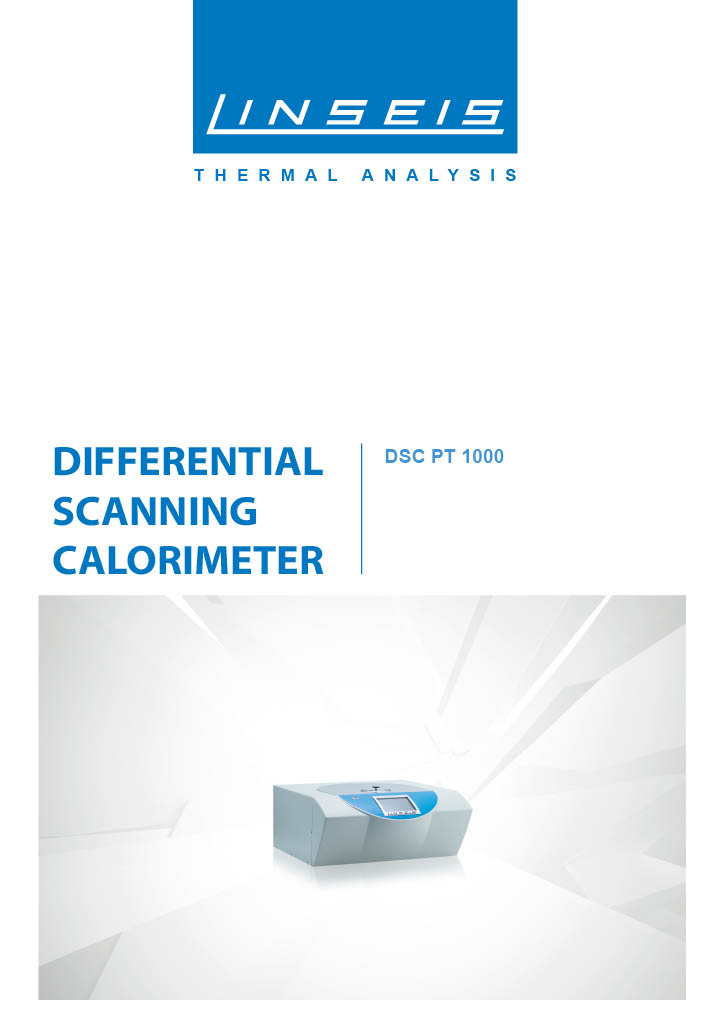Description
To the point
This product was developed as a universal temperature-modeled DSC to cover a wide temperature range (from -180°C to 750°C) for all common applications.
Particular emphasis was placed on an extremely stable baseline and high reproducibility.
The design allows both manual and automatic operation.
The measuring cell is designed to offer maximum mechanical and chemical resistance.
The newly developed ceramic/metal sensor delivers extremely high resolution and sensitivity.
This design offers the highest sensor sensitivity and resolution.
Thanks to our sample changer with up to 90 positions and the automatic gas dosing system, you can operate the device fully automatically at any time.
The following characteristics, among others, can be measured with a DSC: Tg, melting point, crystallization, curing, curing kinetics, onset of oxidation and heat capacity.
Unique features

High-performance sensor
Wide temperature range
Robust design
Versatile
application options
Service hotline
+1 (609) 223 2070
+49 (0) 9287/880 0
Our service is available Monday to
Thursday from 8 am to 4 pm
and Friday from 8 am to 12 pm.
We are here for you!
Specifications
MODEL | DSC PT 1000* |
|---|---|
| Temperature range: | -180°C to 750°C |
| Heating rate: | 0.01 K/min to 100 K/min |
| Cooling rate: | 0.01 K/min to 100 K/min |
| Sensor: | heat flux |
| Vacuum: | - |
| Sample robot: | 90 positions |
| PC Interface: | USB |
| *Specifications depend on the configurations |
Data sheet
Available accessories
- Various gas boxes: manual, semi-automatic and MFC controlled.
- Wide range of crucibles to choose from (gold, silver, platinum, aluminum, stainless steel (high pressure), etc.)
- Platen press (also for high pressure)
- LN2 cooling (down to -180°C)
- Intracooler
- Sample robots with up to 90 positions
Software
Making values visible and comparable
The new Platinum software significantly improves your workflow, as the intuitive data processing requires only minimal parameter input.
AutoEval offers the user valuable assistance in the evaluation of standard processes such as glass transitions or melting points.
Thermal Library Product Identification Tool, provides a database of 600 polymers that enables an automatic identification tool for your tested polymer.
Controlling and / or monitoring the instruments through mobile devices gives you control wherever you are.

General functions
- Software packages are compatible with the latest Windows operating system
- Set up menu items
- All specific measurement parameters (user, laboratory, sample, company, etc.)
- Optional password and user levels
- Undo and redo function for all steps
- Stepless heating, cooling or lingering
- Multilingual versions such as English, German, French, Spanish, Chinese, Japanese, Russian, etc. (user selectable)
- The evaluation software has a range of functions that enable complete evaluation of all types of data
- Several smoothing models
- Complete evaluation history (all steps can be undone)
- Evaluation and data acquisition possible at the same time
- Data can be corrected with zero point and calibration correction
- The data evaluation includes: Peak separation software, signal correction and smoothing, first and second derivative, curve arithmetic, data peak evaluation, glass point evaluation, slope correction.
Zoom/individual segment display, multiple curve overlay, annotation and drawing tools, copy to clipboard, multiple export functions for graphic and data export, reference-based corrections
Applications
Application example: Fructose, Glucose and Sucrose
The three processed sugar species (fructose, glucose and sucrose) have different melting points, which can be precisely determined using the Differential Scanning Calorimeter (DSC).
Thus, this method can be used to identify compounds in substance mixtures as well as investigate the decomposition and melting behavior of foods and other products.


Application example: OIT “Oxidative Induction Time”/ temperature
To be able to predict aging and oxidation behavior of polymers such as PE (Polyethylene, a typical used material in packaging), this so called OIT-test is typically used. Therefore the polymer is heated under influence of oxygen using a DSC.
The application shows the OIT measurement of a common PE-sample.
First, the polyethylene sample is heated to 200°C in an argon atmosphere at a heating rate of 10K/min.
After 3 minutes in equilibrium, the atmosphere is changed from argon to oxygen.
After a further 5 minutes, the exothermic oxidation of the sample begins. The OIT is the time passed between the switch of gas atmosphere and the onset of oxidation reaction.
Application example: spontaneous combustion of cotton fibers
A sample of fabric material made of inorganic minerals with cotton fiber content was measured using a DSC PT 1000 to determine the auto-ignition temperature (ignition point) and heat of combustion of the cotton content.
It is important to distinguish between flash point and ignition point.
The flash point describes the temperature at which a substance can be ignited with the aid of an external ignition source such as a spark, while the auto-ignition temperature indicates the temperature at which a substance burns without an external ignition source.
The sample was heated from room temperature to 600°C at 10 K/min.
The combustion peak of the cotton components is clearly visible at around 430°C.
The enthalpy released is about 60 J/g, based on the weighed mass.
This allows the cotton content to be quantified.
The black curve shows the heat flow signal, the red curve shows the derivation of the DSC signal over the temperature in order to determine the exact start and end point of the reaction as well as the maximum of the reaction peak.

Well informed

